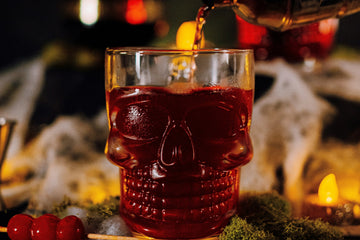A Guide to Aged Gin: What is it, How Long is Gin Aged, and How to Age Gin at Home
by Emily Jones on Oct 11, 2024

What is an ‘ageing process’ in food and drink?
‘Aging’ or ‘maturation’, is the process of allowing a food or drink to mature over a period of time before being consumed. This is typically done to enhance the flavour or texture, typically giving a deeper flavour. but this process only works on certain types of food or drink, with the most popular ones to age including cheese, wine, or meat.
The ageing process can last anywhere from a few months to multiple years and even decades. When it comes to beverages, the most popular alcoholic drinks to be aged are wine and whiskey. Whilst these beverages have different ageing processes, they are both typically stored in barrels for years, giving the drink time to mature and develop their flavours and aromas.
Types of Aged Gin
Gin is not typically aged as its key characteristics would be lost or altered during the ageing process. Ageing a drink such as whisky allows it to develop deep flavours, which isn’t needed for gin which is typically enjoyed for its clean, fresh, botanical flavours.
However, the concept of aged gin has been rising in popularity in recent years, sought after by those gin-lovers who are looking for something new and interesting.
Types of barrel-aged gin
Barrel-aged gin was first popularised in the 1900’s, and refers to gin that has been stored in a barrel for a period of time before being consumed. During this process, the gin soaks up flavours from the wood, and sometimes even flavours of other spirits that have been stored in the barrels previously.
Barrel-aged gin is commonly made in barrels made out of oak (Including American, Virgin, European, and French oak) but can also be made from barrels made out of the following:
Chestnut
Mulberry
Cherry
Acacia
Barrels which previously stored wine and bourbon whisky are very commonly used for making barrel-aged gin, but brandy is also sometimes used.
Oak Rested Gin
Oak rested gin is gin which has been aged in oak barrels. Typically, old oak barrels are reused as they are more effective at flavouring the gin. Oak barrels can add vanilla, caramel, and spiced notes, depending on what type of oak the barrel is made from.
Ex-Bourbon Aged Gin
Maturing gin in barrels which previously store bourbon whiskey helps flavour the gin with notes of toffee and oak. Ex bourbon cask-aged gin gives the gin warm notes which are often found in whisky, this gives gin an alternative taste than the usual fresh and light notes of gin.
Ex-Wine Aged Gin
Barrels which previously stored red wine are the most common type used in ex-wine aged gin, but white wine and sherry barrels are also sometimes used depending on the desired flavour. The process of ageing gin in ex-wine barrels adds a complex layer of the gin. Ex-wine aged gin can be rich and robust, or more delicate depending on the type of wine which is used.
Can I age gin at home?
To age gin at home, the easiest way is to purchase a few bottles of a good quality gin and add this to a small oak barrel. These barrels can be purchased new, but pre-owned barrels will add a more complex flavour. Once you have added your gin to the barrels, they should be stored in a cool, dry place and rotated periodically (around once per week). For a small barrel of around 1-5 litres, the gin should be ready to taste after around 6 weeks. At this point, you should test the gin weekly until it has developed the desired taste.




